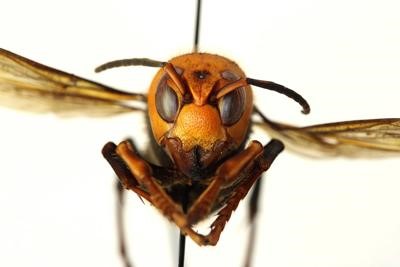WSU Scientists Researching Possible Reemergence of Asian Giant Hornet in Washington State.
WSDA
Back in December, we (unfortunately) told you about some invasive Asian giant hornets being discovered in Washington state.
Now, Washington State University scientists are partnering with other agencies in researching the bee-killing hornets and preparing for their possible emergence this spring.
A Giant Asian hornet was found on a property in Blaine, Wash., back in early December. This hornet hadn’t been found in Washington before, and the WSDA says while it isn’t usually aggressive towards people, it can lethally sting other bees (particularly a threat to honey bees).
Susan Cobey, a bee breeder with the WSU Department of Entomology, describes the giant hornet as “something out of a monster cartoon with this huge yellow-orange face.”
“It’s a shockingly large hornet,” added Todd Murray, WSU Extension entomologist and invasive species specialist.
“It’s a health hazard, and more importantly, a significant predator of honey bees.”
WSU Scientists expect the giant hornets to again emerge this spring, saying they will start to become active this month. Researchers, the WSDA and beekeepers will be working with citizens to help find the hornets, study them and eradicate their spread.
It is unknown when the giant hornets started arriving in North America, but the Blaine sighting and two unconfirmed sightings in Custer, Wash., have scientists preparing for more. The life cycle of the hornets begin in
April when queens emerge from hibernation, feed and build nests in underground dens. Colonies then grow and send out workers to find food and prey. Researchers say the hornets are most destructive later in upcoming seasons.
“Hornets are most destructive in the late summer and early fall, when they are on the hunt for sources of protein to raise next year’s queens,” research indicates.
As growers depend on honey bees to pollinate northwest crops, many are working together to prevent these hornets from threatening them.
“Just like that, it’s forever different,” Murray said. “We need to teach people how to recognize and identify this hornet while populations are small, so that we can eradicate it while we still have a chance.”
WSU scientists continue to spread awareness of the hornets to citizens, relaying fact sheets, WSDA information, tips and ways to report sightings.
“Don’t try to take them out yourself if you see them,” WSDA entomologist Chris Looney said. “If you get into them, run away, then call us! It is really important for us to know of every sighting, if we’re going to have any hope of eradication.”
To report an Asian Giant Hornet sighting, contact the Washington State Department of Agriculture Pest Program at 1-800-443-6684, pestprogram@agr.wa.gov or online at agr.wa.gov/hornets.
For questions about protecting honey bees from hornets, contact WSU Extension scientist Tim Lawrence at (360) 639-6061 or timothy.lawrence@wsu.edu.
________________________________________________________________________________










